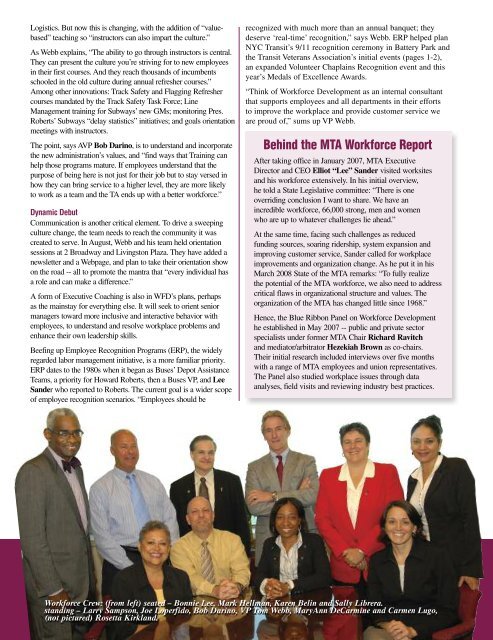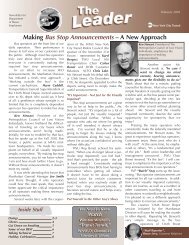September 11 Seven Years Later: Lest We Forget*
September 11 Seven Years Later: Lest We Forget*
September 11 Seven Years Later: Lest We Forget*
Create successful ePaper yourself
Turn your PDF publications into a flip-book with our unique Google optimized e-Paper software.
Logistics. But now this is changing, with the addition of “valuebased”<br />
teaching so “instructors can also impart the culture.”<br />
As <strong>We</strong>bb explains, “The ability to go through instructors is central.<br />
They can present the culture you’re striving for to new employees<br />
in their first courses. And they reach thousands of incumbents<br />
schooled in the old culture during annual refresher courses.”<br />
Among other innovations: Track Safety and Flagging Refresher<br />
courses mandated by the Track Safety Task Force; Line<br />
Management training for Subways’ new GMs; monitoring Pres.<br />
Roberts’ Subways “delay statistics” initiatives; and goals orientation<br />
meetings with instructors.<br />
The point, says AVP Bob Darino, is to understand and incorporate<br />
the new administration’s values, and “find ways that Training can<br />
help those programs mature. If employees understand that the<br />
purpose of being here is not just for their job but to stay versed in<br />
how they can bring service to a higher level, they are more likely<br />
to work as a team and the TA ends up with a better workforce.”<br />
Dynamic Debut<br />
Communication is another critical element. To drive a sweeping<br />
culture change, the team needs to reach the community it was<br />
created to serve. In August, <strong>We</strong>bb and his team held orientation<br />
sessions at 2 Broadway and Livingston Plaza. They have added a<br />
newsletter and a <strong>We</strong>bpage, and plan to take their orientation show<br />
on the road -- all to promote the mantra that “every individual has<br />
a role and can make a difference.”<br />
A form of Executive Coaching is also in WFD’s plans, perhaps<br />
as the mainstay for everything else. It will seek to orient senior<br />
managers toward more inclusive and interactive behavior with<br />
employees, to understand and resolve workplace problems and<br />
enhance their own leadership skills.<br />
Beefing up Employee Recognition Programs (ERP), the widely<br />
regarded labor management initiative, is a more familiar priority.<br />
ERP dates to the 1980s when it began as Buses’ Depot Assistance<br />
Teams, a priority for Howard Roberts, then a Buses VP, and Lee<br />
Sander who reported to Roberts. The current goal is a wider scope<br />
of employee recognition scenarios. “Employees should be<br />
recognized with much more than an annual banquet; they<br />
deserve ‘real-time’ recognition,” says <strong>We</strong>bb. ERP helped plan<br />
NYC Transit’s 9/<strong>11</strong> recognition ceremony in Battery Park and<br />
the Transit Veterans Association’s initial events (pages 1-2),<br />
an expanded Volunteer Chaplains Recognition event and this<br />
year’s Medals of Excellence Awards.<br />
“Think of Workforce Development as an internal consultant<br />
that supports employees and all departments in their efforts<br />
to improve the workplace and provide customer service we<br />
are proud of,” sums up VP <strong>We</strong>bb.<br />
Behind the MTA Workforce Report<br />
After taking office in January 2007, MTA Executive<br />
Director and CEO Elliot “Lee” Sander visited worksites<br />
and his workforce extensively. In his initial overview,<br />
he told a State Legislative committee: “There is one<br />
overriding conclusion I want to share. <strong>We</strong> have an<br />
incredible workforce, 66,000 strong, men and women<br />
who are up to whatever challenges lie ahead.”<br />
At the same time, facing such challenges as reduced<br />
funding sources, soaring ridership, system expansion and<br />
improving customer service, Sander called for workplace<br />
improvements and organization change. As he put it in his<br />
March 2008 State of the MTA remarks: “To fully realize<br />
the potential of the MTA workforce, we also need to address<br />
critical flaws in organizational structure and values. The<br />
organization of the MTA has changed little since 1968.”<br />
Hence, the Blue Ribbon Panel on Workforce Development<br />
he established in May 2007 -- public and private sector<br />
specialists under former MTA Chair Richard Ravitch<br />
and mediator/arbitrator Hezekiah Brown as co-chairs.<br />
Their initial research included interviews over five months<br />
with a range of MTA employees and union representatives.<br />
The Panel also studied workplace issues through data<br />
analyses, field visits and reviewing industry best practices.<br />
Workforce Crew: (from left) seated – Bonnie Lee, Mark Hellman, Karen Belin and Sally Librera.<br />
standing – Larry Sampson, Joe Loperfido, Bob Darino, VP Tom <strong>We</strong>bb, MaryAnn DeCarmine and Carmen Lugo,<br />
(not pictured) Rosetta Kirkland.



